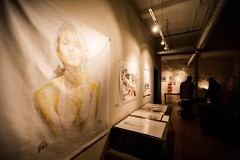Derrick Hollowell drops a stack of large paper bags onto the floor. He turns toward me and says “We’re going to curate this show together.” The bags are full of paintings and sketches composed by Hollowell during his 10 years of working along the Avenue for the Arts. He is preparing his loft for the Free Radical Gallery Show, set to take place in only five hours. His title of his exhibition is “Archival.” It intends to explore the evolution of Hollowell’s work and of his perception of his neighborhood over the past nine years of living in the Avenue for the Arts. During this time, Hollowell has used his artist live/work studio for numerous shows, including the Free Radical.
“The Free Radical is close to my heart,” he says.
Hollowell is friendly, welcoming and with an instinctive ability to teach. For the past several years, he has divided his time between creating art and teaching art. His students have largely consisted of children and adults with cognitive disabilities. Kindling creativity in his students brings him excitement. He says that when he first started teaching, he would help his young students paint realistic depictions in their work. Now, Hollowell encourages colorful skies and fantastical work. He can identify when children start to become more self-conscious of their work and is intentional about making them feel confident in their imaginative ideas.
“It starts to happen around 4 years," he says. "That’s when you gotta catch them.”
Hollowell himself has big ideas. He is a self-proclaimed idealist. He moved into his current loft with the hopes of eventually being able to purchase the entire building and transforming it into an open and interactive community arts space.
“I wanted it to be SoHo,” he says. “I didn’t move here to be residential.”
His live/work space on South Division was designed to be accommodating to artists. It’s a cloudy afternoon, but Hollowell’s floor-to-ceiling windows flood the large, open space with enough natural light to replace any indoor electrical lighting. The hardwood floors are spattered with paint and color. There is artwork everywhere: hanging on the walls, stacked in piles and leaning against furniture. He has a music studio set up near the back of his space. His loft is busy with work but simply furnished.
Hollowell moved into this studio in 2005. He had just returned for what he thought to be a temporary stay in Grand Rapids after pursuing a career in the hiphop music industry with a group of friends. Although they had recorded an album, produced a couple of music videos and had successfully made several connections in Los Angeles, Hollowell was lured back into the art scene in his hometown after learning about Dwelling Place’s initiative of opening up affordable artist live/work spaces in downtown Grand Rapids. The Grand Rapids native immediately signed up for a waiting list for the apartment building, and soon had a newly renovated artist’s loft to call home.
However, Hollowell soon gained an understanding about the many challenges he would face as an artist in downtown Grand Rapids. Like many artists, Hollowell struggled to make enough income to support his passion. An affordable living space was one of the draws for him to move into the loft in the first place. He said he had been convinced by an advertisement that utility costs would be no more than $40 in his new studio. He was shocked and disappointed when he received a total of over $100 in utility bills after he first moved into the loft.
“It was like a slap in the face,” he says. It was this event that led to Hollowell’s idea of organizing with other resident artists in an attempt to create a sense of community and to help develop his neighbors into activists. He was disappointed to receive no support from his neighbors.
Although artists living in Dwelling Place sponsored live/work spaces qualify for affordable housing rates, Hollowell says that working as a full time artist continues to be a struggle.
“I have been split between community work and developing myself as an artist,” he explains. Hollowell recently made the difficult decision to step back from his work as an arts educator in order to focus on honing his craft, selling his art and promoting his work internationally.
“I like establishing relationships with my students. I’ve learned that consistency matters. It’s so fulfilling, but I don’t know if I can give what I have to give and focus on my work at the same time. I’m torn. I miss teaching," he says. “Money changes attitudes. When I did my work at Hopcat, I felt good because my bills were paid. I am now caught between commercial art and fine art. ‘Commercial’ because I need to sell my work and am consumed by other worries. ‘Fine art’ because I work to attain satisfaction from my work. I need to focus on expanding my portfolio. I need to get 20-30 good paintings done. Soon.”
Hollowell’s hopes to expand his reach far beyond Grand Rapids in the upcoming year. Hollowell has long felt that the possibilities for his realization as an artist have been cut short in his hometown. When asked to describe his work, Hollowell describes his aesthetic as “Seventies meets ‘single black mother’ meets ‘Muhammad Ali is the greatest’ meets ‘hiphop influenced my life’.”
“That’s what I express through my work and that’s not what’s selling in Grand Rapids right now,” he says. During his youth, Hollowell was influenced by several artists, including local artist Paul Collins. Looking back at his development as an artist, he realizes he felt compelled to depict paintings related to historical and present African American culture, keeping in mind that he was one of the only prominent African American artists in downtown Grand Rapids.
“Race has always been in the backdrop. I felt pressure to be the ambassador for ‘black.’ I feel like I’m walking a tightrope between race and art,” he says. He has had numerous opportunities to display work in local businesses and public spaces, nevertheless, over the decades Hollowell has lived in Grand Rapids, he has felt excluded and burned through his encounters with the local arts scene.
“My big idea was to share my space and work, but I got a big ‘no thanks’. Is it coincidental? Is it my personality? So much of it had to do with race. Here, I’m black before I’m an artist. In GR, even nudity in art is a big deal," he says. "Race is a whole other frontier to deal with.”
Hollowell said that his viewpoints are often dismissed with accusations from others of “pulling the race card.”
“I didn’t expect to be met with that," he says. "Art is where you can have radical views. Even with the so called ‘progressive movement,’ I hear comments like ‘that’s just Derrick being Derrick.’ [Racism] should be unbelievable. Grand Rapids is an intensely condensed case study of tolerance, coexistence, racial gentrification, classism [and] urban renewal. Out of that case study, I have to ask: what do I do now? Grand Rapids is my hometown, but this is indefensible.”
Hollowell brings up an issue he believes is interrelated: affirmation.
“Artists search for affirmation,” he says. The support and affirmation that he has received from friends and family has been generous. Throughout his years creating art, Hollowell found that same support from art institutions to be lacking.
“I had to convince myself I’m qualified to speak, to curate, to serve and to show art,” he said. “For artistic confidence, I started a website and started using Facebook as a promotional tool.” After some time of promoting his work online, he received an email from the Museum of Modern Art, informing him that it had purchased one of his paintings. Although the news was exciting for Hollowell, he was surprised to find out that the process of MOMA’s purchase of art was not as grand of an ordeal as he had expected. He initially believed the purchase would help him set off in his art. Instead, the purchase seemed to go unnoticed.
“I don’t have it figured out. Nope, I don’t," he says. "I have a cool space. I know the day is coming when I might be kicked out based on finances. A big part of why I stay in Grand Rapids because of my space. It’s become an anchor, it’s bound a weight on me.” Hollowell sees that not only is the convenience and beauty of his loft valuable, but that it serves as a place of refuge to the disenfranchised and disconnected. Has allowed students and other artists use the space for events, shoots, videos and work. “Maybe staying here is also a thumb up to the nose to those who don’t want me here.”
Hollowell admits that he has seen tremendous physical change in his neighborhood, but still believes Grand Rapids has a ways to go in inclusivity. He remains hopeful for a successful year of making and selling his work. He has had a wide array of experiences in his hometown.
“That’s my hard truth that makes people queasy, or angry or disdainful," he says. "In trying to relay my experience in the most genuine way as possible, I’m not emphasizing the other sides. They are such opposite fields. To wake up at 7 a.m. and see the sunrise from here… I can’t count the number of ‘wows’ I’ve had. I’ve shared this space with people who have never seen an art gallery, who’ve never seen a black person establish his or her own aesthetic. My experiences have been nearly as fulfilling as [they] have been exasperating. I think that for the sake of people early on their quest, it’s important for them to hear this side of the story so their idealism isn’t bruised.”
You can learn more about Hollowell’s work by visiting his Etsy page, VitoArt.
The Avenue for the Arts is a neighborhood title for the South Division commercial corridor. We are residential, commercial and nonprofit groups working together in a creative community. We are residents in Heartside, and active participants in shaping change in our neighborhood. In 2005, we chose the Avenue for the Arts as a title to represent our commercial corridor and the projects and events that we create. Because the Avenue is powered by volunteers, guest writers create our Rapidian content. Special thanks to Avenue for the Arts intern Claudia Armijo for her contribution to this piece.
The Rapidian, a program of the 501(c)3 nonprofit Community Media Center, relies on the community’s support to help cover the cost of training reporters and publishing content.
We need your help.
If each of our readers and content creators who values this community platform help support its creation and maintenance, The Rapidian can continue to educate and facilitate a conversation around issues for years to come.
Please support The Rapidian and make a contribution today.



